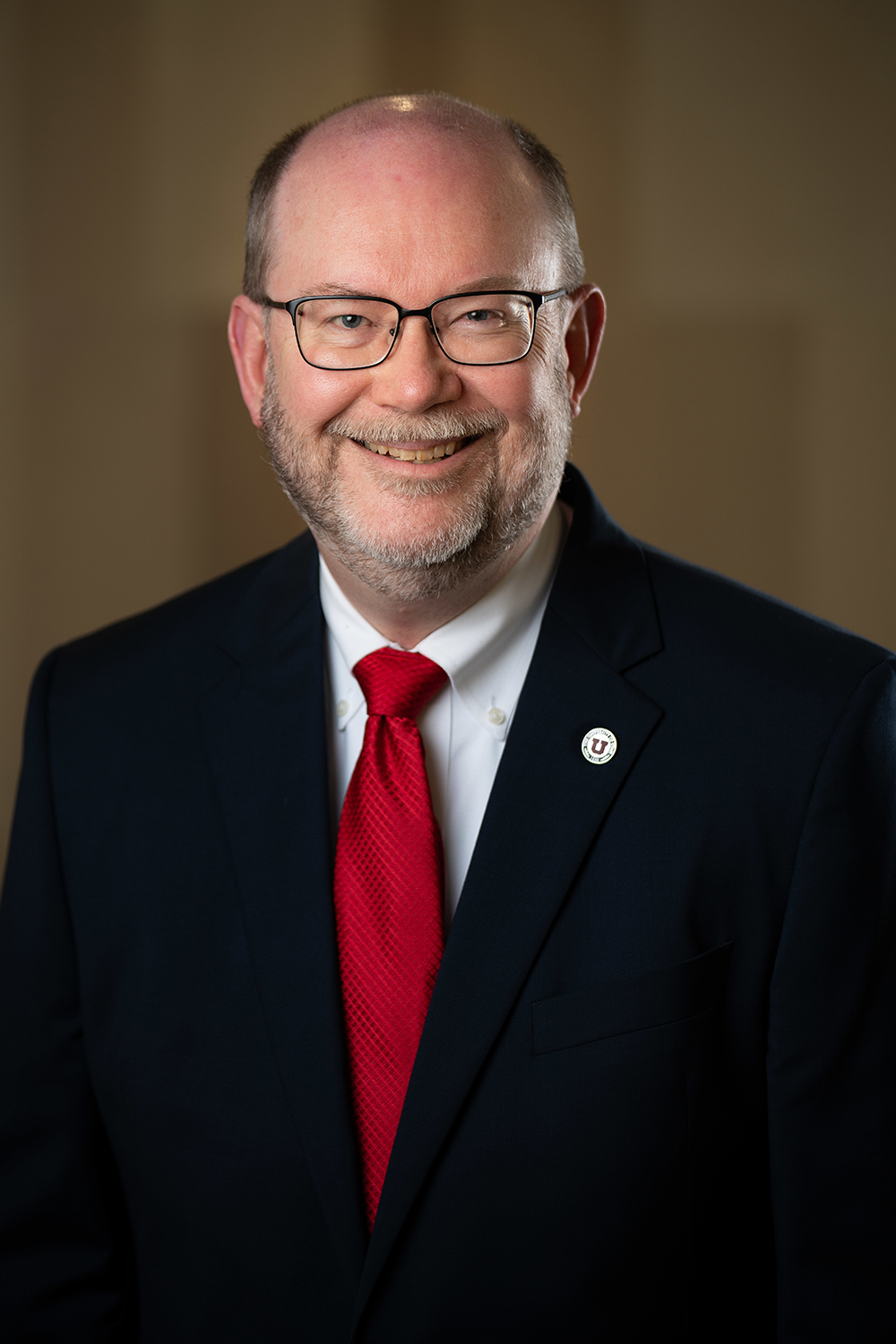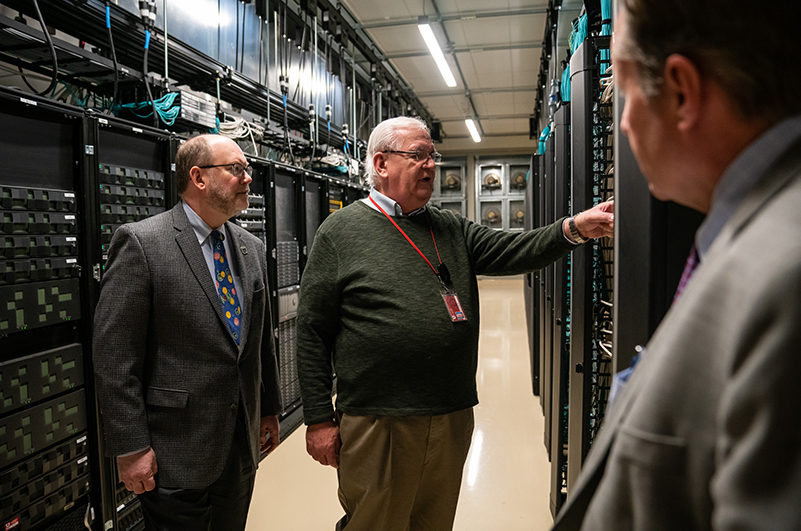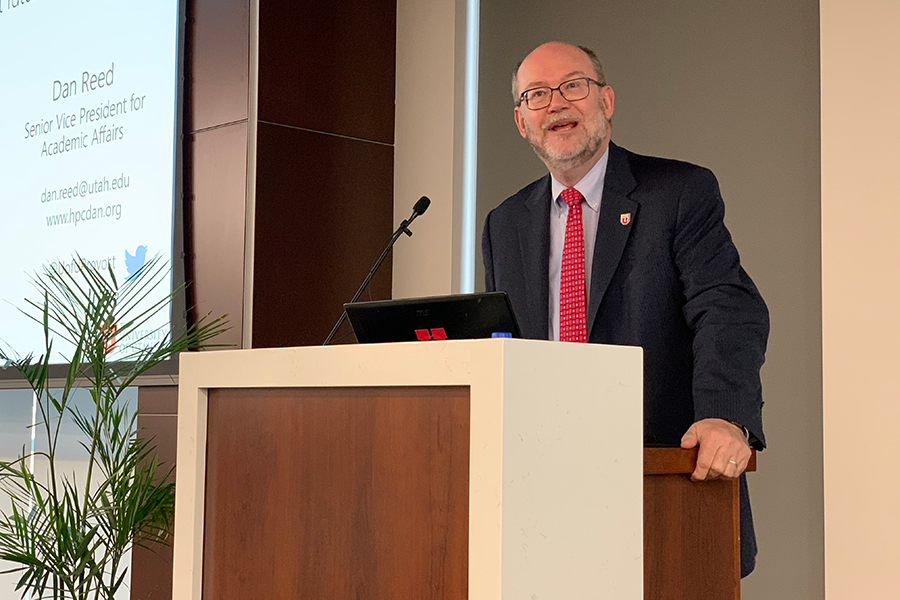You’re accessing archived content
This is archived content from the UIT website. Information may be outdated, and links may no longer function. Please contact stratcomm@it.utah.edu if you have any questions about archived content.
SVP Dan Reed shares his thoughts on and vision for IT at the U
 |
|
Senior Vice President for Academic Affairs Dan Reed, Ph.D. |
From academia to corporate America, Dan Reed’s reputation as an innovator, researcher, scholar, policymaker, and leader in higher education precedes him.
His job titles alone signal the prestige of his positions: senior vice president of Academic Affairs at the University of Utah, vice president for research and economic development at the University of Iowa, corporate vice president and technology policy leader at Microsoft, and director of the National Center for Supercomputing Applications, to name a few.
In most information technology and computing circles, however, Reed is known simply as HPC Dan.
A self-professed “”“computer geek,” Reed became known for his work in computer science and supercomputing. Over the years, his research and scholarship expanded to include cloud and edge computing, bioinformatics, and cyberinfrastructure, among others.
Now at the helm of academic affairs for the top research university in Utah, Reed is charged with furthering four key initiatives to promote student success, generate knowledge, engage communities, and ensure the long-term vitality of the U. He also oversees academic and long-range institutional planning, with oversight of various U organizations, including University Information Technology (UIT).
UIT recently sat down with Reed to talk about his vision for the university, including how UIT and its organizations can support that mission.
How does your background in research, technology, and the private sector inform your strategy for academics at the university?
By virtue of his background, Reed says he’s been fortunate to work with people in a wide range of disciplines, giving him perspective on the rewards and metrics that different parts of academia value and appreciate. That’s been valuable in breaking down barriers and building bridges and collaborations.
But he also learned a lot by asking basic questions and at times, accepting his own learning curve.
“In academia, we often are rewarded for intellectual depth, but the types of big issues we face also require breadth to see connections across disciplines and opportunities.”
Reed, noting how often people zero in on their differences, says he prefers to look for common aspirations and asks how he can enable those.
“When people are mutually invested in things, they will happen.”
Besides the recommendations from the 2015 Deloitte Consulting study, which cited a host of decentralized IT services, how do you envision IT, or UIT in particular, evolving to better serve the campus community?
The fundamental question about centralized and distributed services, Reed says, is whether there is significant value in having a different version of a service. For most common services like the network, the answer is “no.” Other enterprise IT services may be centralized but function differently for various groups. ’Institutional Advancement’s constituent relationship management (CRM) system project — a broad campus-wide initiative led by Vice President Heidi Woodbury — is a terrific example, he says.
“How you use that data may be domain-specific, but the notion of having the data is really important.”
On the research front, Reed says the U needs to resolve how it will manage the explosive growth of research data.
“The federal mandates for openness and data retention will require thoughtful collaboration and undoubtedly some resource investment. It’s important from a compliance perspective, but it's also important because it’s an enabler for research and scholarship.”
 |
|
SVP Dan Reed tours the Downtown Data Center with UIT Leadership on February 19, 2019. |
The university also needs to consider how to address the dramatic growth of online and just-in-time education, as well as how it will continue to expand its national and global footprint, Reed says. The U has an opportunity to deliver everything from short courses and certificates, that give people some tactical professional expertise, to credit-bearing certificates and online degrees.
“We need our enterprise [IT] systems to make that process seamless and invisible to potential students. Whether you're signing up for a weekend course in photography or a doctorate in high-energy physics, the process should look similar. … The ability to deliver that educational content to people where they are, when they need it is part of the U’s expanding mission to respond to changing social needs.”
How can UIT, and its Center for High Performance Computing in particular, be leveraged further to expand undergraduate research?
In May, Reed wrote about his support for the current efforts to expand undergraduate research at the U, which are in part designed to bridge the divide between classroom and hands-on learning.
“The thing that allows students to persevere and to finish their degree is building a personal connection — to feel like you belong to a community. … And the distinguishing characteristic of a research university is that we not only transmit existing knowledge, we actually create new knowledge. Undergraduate research experiences involve people in that.”
So much of research and scholarship relies on access to information technology, Reed says, so whether you’re doing chemistry research or humanities scholarship, you’re likely using a computing resource or relying on research computing.
“Certainly, CHPC is a critical piece of that — not only the way it supports externally funded [research], but also how it's used on campus to support undergraduate research and scholarship.”
More broadly, he says, students need access to resources that support digital literacy.
“Being able to understand whether someone is deceiving you with data is a true-life skill today. And the way you learn that is through exposure to technical and research computing. It’s not the only way but one of the ways.”
What opportunities do you see for the university to partner or contract with companies in the state’s Silicon Slopes community or other Utah tech companies?
Given Utah’s vibrant and rapidly growing tech sector, there’s an almost insatiable demand for tech talent, Reed says. But the state doesn’t have the STEM workforce needed to fill those jobs. The U, which Reed says now produces almost half of Utah’s STEM graduates, is helping to close that gap. The conversation with Silicon Slopes is about striking a balance between training people in underlying principles and modern tools.
“The tech sector is looking for people who have both of those skills — a deep understanding, because that's kind of the perpetual knowledge base, and fluency with current technology. Some conversations have been about how we best cross that bridge of fluency in current technology, because we can only teach some of those in the classroom. That's where some of the short courses, continuing education, and other partnerships come into play.”
 |
|
SVP Dan Reed speaks at the 50th anniversary celebration for ARPANET on October 7, 2019. |
Another topic, which focuses on K-12, relates to digital literacy. Conversations include how the U might partner with CS for All and code.org, train more teachers in computational skills, and support program enrichment. (Last week, for example, the U hosted the 2019 national CSforALL Summit, where guests learned about the latest in computer science and tech education resources and ideas.) The goal, Reed says, is to ensure students are exposed to computational thinking.
“That’s a life skill — how to take a complex problem, break it down into pieces, find solutions to the pieces and reassemble them. You don't have to be a software developer to value that skill. That's how you approach complex problems in life.”
As always, some conversations revolve around which tech products by Silicon Slopes companies might be relevant to the university and where they might be deployed (enterprise or research and education), Reed says.
How do you think ARPANET cemented the University of Utah as a technological innovator?
In some sense, Reed says, ARPANET started in part because there were thought leaders and innovators at the U. Plus, the ski resorts near Salt Lake City were a great place to retreat and think about things. In fact, the concrete plans to connect computers together into the world’s first far-reaching communications network came up during a 1968 meeting of the nation’s top computer scientists and government officials at Alta Ski Resort.
“[ARPANET] in part happened because there were some early pioneers at Utah who were really at the bleeding edge of technology. The ideas that led to Adobe, that led to the history of computer graphics here, it was that visibility.
“You also have to realize that 50 years ago, the computing community was tiny compared to what it is now. … And like most novel ideas, a small number of people with vision and belief in what the world could be were prepared to take some risks, and that's what happened here. And it's led to a long, long history of innovation that continues to today.”
Do you have any words of wisdom or advice you would like to share with UIT employees?
In 2013, Reed recalls, he debated science fiction writer Bruce Sterling in Iowa City during an exchange called “Imagining and Being Imagined by Technologies: A Conversation with Two Futurists.” They’d ask each other a version of this question, and his response went something like this:
On your circle
“Surround yourself with people unlike you. They will challenge your belief system and make you learn new things.”
On taking risks
“Take some risks, but calculated risks. And know that, by definition, some of those things will fail, but you will learn as much from them as the successes. My grandfather used to tell me, 'Make new and original mistakes; life's more interesting that way.’"
“Experience should not be your only teacher, though. The price of tuition at the college of experience is pretty high.”
On the future of technology
“We live in an IT world where changes in speeds, capacities, and price make some things that were previously impossible now commonplace. … Some of the trick of predicting the future is to look at what's true now and ask yourself which of those things can change and which cannot. And the ones that can change are the ones that are likely to be predictors of what the future might be.
“The conversation about ARPANET? Ask the question that people in the end ask themselves, 'What would happen if global communication were effectively free?’ and you can see a lot of things have happened because of that. We've been able to send telegrams for 100-plus years, but it was slow and it was expensive. The fact that you can chat for hours with someone on the other side of the world, for nothing, is transformative.”
Node 4
Our monthly newsletter includes news from UIT and other campus/ University of Utah Health IT organizations, features about UIT employees, IT governance news, and various announcements and updates.
